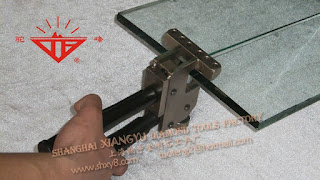There are a number of types of cut running pliers. These photos show some of them.


The apparently most popular is this:
Cushions
It
is frequently difficult to find replacements for the plastic cushions
that come with a new pair of cut runners.
People resort to a number of means to provide a substitute. Some wrap electrical tape around the jaws,
others use fabric bandages (Elastoplast/band aids). I have even used the liquid plastic that is designed
for coating tool handles.
However, if you adjust the cut runners appropriately, you
can use them to run your scores even without cushions. The purpose of these cushions is only to
compensate for too much pressure in running the score.
Use without covers
You can run the score without cushions by using the
adjustment screw on the top jaw of the tool. Yes, it does tell you which is the
top jaw without having to check the end of the runners, but it has a more important
use. It is not just a pretty cool way to
tell which is up.
Its purpose is to adjust the width of the opening so that it
provides the appropriate amount of bending force no matter how much pressure
you exert at the handles. If you are
running scores in three-millimetre glass, set the jaws to that width by turning
the screw until the jaws are that width apart.
Place the jaws in line with the score, aligning the
mark on the top jaw with the score line and squeeze the pliers. As you squeeze, the curved jaws provide
enough bending force to run the score without over stressing the glass. It is the adjustment
screw that limits the over-stressing of the glass during the running of the
score. Yes, you may not be able to run the whole length of the score
this way, but you can repeat from the other end and that is usually enough to
complete the running of the score.
You
can continue to use cushions of various sorts with this adjustment for
thickness, but I found that these were not necessary when the runners were
properly adjusted. In fact, I found that
soft cushioning made more difficulties than using them with the bare
metal. I discovered this during the
period of using the liquid plastic coating as used for tool handles. I dipped the jaws multiple times to give a
cushioning effect and it worked fine.
The cut runners continued to work even after the coating had
worn off. It was then that I realised I
could control the running pressure more directly than by having a cushion
between the glass and the jaws.
Setting the spacing
An
easy way to set the correct opening of the jaws is to test against the glass
you are about to score and break. Place
one side of the jaws against the edge of the glass. Slide that corner just a
few millimetres over the glass. Turn the
set screw on the top of the jaws anticlockwise until they are fitting the glass
snugly. Back off a half turn (clockwise)
so the jaws move easily along the edge.
This is now set to run the score on this glass.
Open
the jaws and place the centre mark in line with the score. Close them gently and you can observe the arc
of the jaws above the score line. Squeeze the handles and the score will run
along the line away from the cut runners.
As you have adjusted the opening, no matter how hard you squeeze the cut
runners, you cannot add more pressure.
This means you avoid crushing the glass.
The principles
The
curve of the jaws is designed to provide the bending force required to run the
score. The radius of the curve has been
designed to provide the correct bending pressure for differing sizes of
glass. The most common ones are useful
for glass up to, but not including, 6mm glass.
The screw adjustment provides compensation for differing thicknesses of
glass. Setting the width of the gap to
match the thickness of the glass prevents the application of too much pressure.
Thicker glass
For
thicker glass you need cut runners with wider jaws. These usually are fitted with three points to
apply the breaking pressure - one under the score and one each side of the
score on the top. Again, these are
adjusted to be just less than snug to the glass before applying the pressure.
 |
| One example of cut runners for thick glass. There are a variety of others. |















